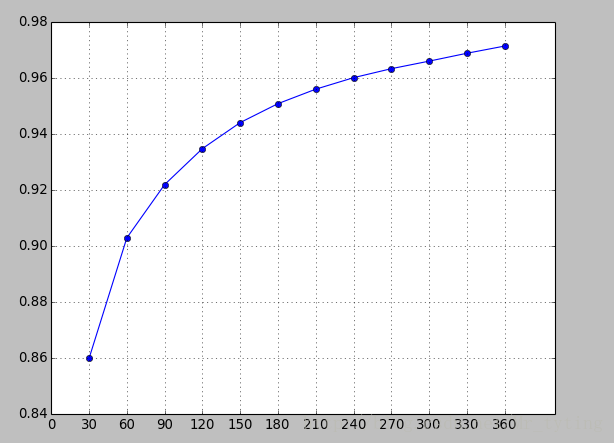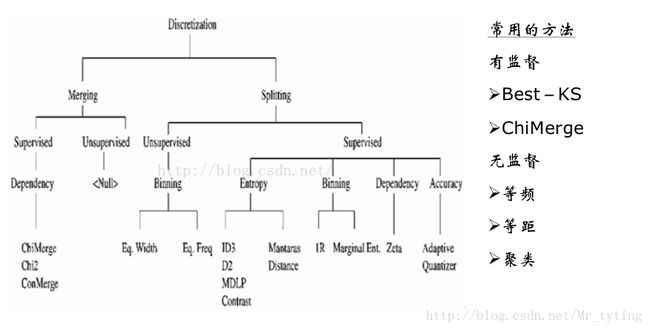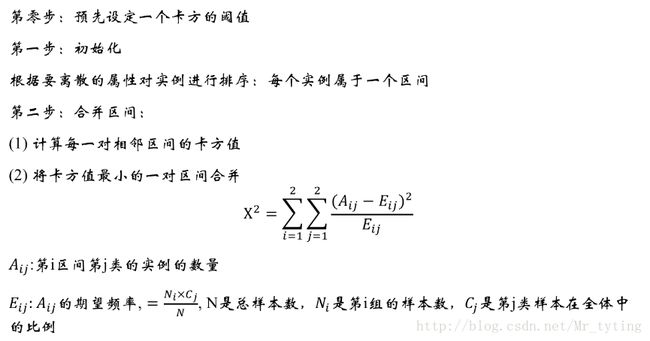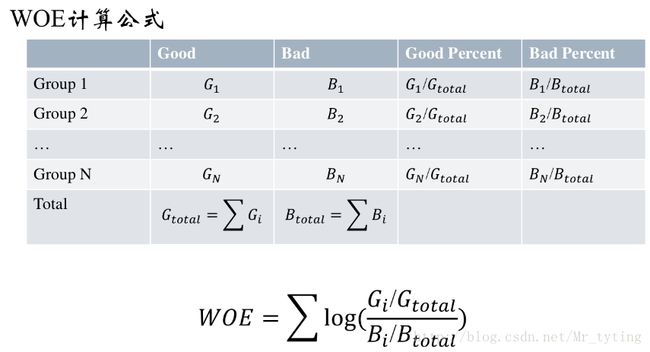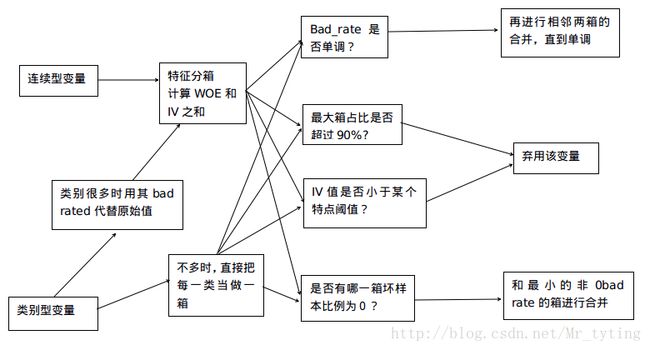金融风控-- >申请评分卡模型-- >特征工程(特征分箱,WOE编码)
这篇博文主要讲在申请评分卡模型中常用的一些特征工程方法,申请评分卡模型最多的还是logsitic模型。
先看数据,我们现在有三张表:
已加工成型的信息:
Master表
idx:每一笔贷款的unique key,可以与另外2个文件里的idx相匹配。
UserInfo_:借款人特征字段
WeblogInfo_:Info网络行为字段
Education_Info*:学历学籍字段
ThirdParty_Info_PeriodN_:第三方数据时间段N字段
SocialNetwork_:社交网络字段
ListingInfo:借款成交时间
Target:违约标签(1 = 贷款违约,0 = 正常还款)
需要衍生的信息
借款人的登陆信息表
ListingInfo:借款成交时间
LogInfo1:操作代码
LogInfo2:操作类别
LogInfo3:登陆时间
idx:每一笔贷款的unique key
客户在不同的时间段内有着不同的操作,故我们最好做个时间切片,在每个时间切片内统计一些特征。从而衍生出一些特征。
时间切片:
两个时刻间的跨度
例: 申请日期之前30天内的登录次数
申请日期之前第30天至第59天内的登录次数
基于时间切片的衍生
申请日期之前180天内,平均每月(30天)的登录次数
常用的时间切片
(1、2个)月,(1、2个)季度,半年,1年,1年半,2年
时间切片的选择
不能太长:保证大多数样本都能覆盖到
不能太短:丢失信息
我们希望最大时间切片不能太长,都是最好又能包含大部分信息。那么最大切片应该多大呢?
#coding:utf-8
import pandas as pd
import datetime
import collections
import numpy as np
import random
import matplotlib.pyplot as plt
def TimeWindowSelection(df, daysCol, time_windows):
'''
:param df: the dataset containg variabel of days
:param daysCol: the column of days
:param time_windows: the list of time window,可分别取30,60,90,,,360
:return:
'''
freq_tw = {}
for tw in time_windows:
freq = sum(df[daysCol].apply(lambda x: int(x<=tw))) ##统计在tw时间切片内客户操作的总次数
freq_tw[tw] = freq/float(len(df)) ##tw时间切片内客户总操作数占总的操作数比例
return freq_tw
data1 = pd.read_csv('PPD_LogInfo_3_1_Training_Set.csv', header = 0)
### Extract the applying date of each applicant
data1['logInfo'] = data1['LogInfo3'].map(lambda x: datetime.datetime.strptime(x,'%Y-%m-%d'))
data1['Listinginfo'] = data1['Listinginfo1'].map(lambda x: datetime.datetime.strptime(x,'%Y-%m-%d'))
data1['ListingGap'] = data1[['logInfo','Listinginfo']].apply(lambda x: (x[1]-x[0]).days,axis = 1)
timeWindows = TimeWindowSelection(data1, 'ListingGap', range(30,361,30))
fig=plt.figure()
ax=fig.add_subplot(1,1,1)
ax.plot(list(timeWindows.keys()),list(timeWindows.values()),marker='o')
ax.set_xticks([0,30,60,90,120,150,180,210,240,270,300,330,360])
ax.grid()
plt.show()
由上图可以看出,在0-180天的时间切片内的操作数占总的操作数的95%,180天以后的覆盖度增长很慢。所以我们选择180天为最大的时间切片。凡是不超过180天的时间切片,都可以用来做个特征衍生。
选取[7,30,60,90,120,150,180]做为不同的切片,衍生变量。
那么我们来选择提取哪些有用的特征:
- 统计下LogInfo1和LogInfo2在每个时间切片内被操作的次数m1。
- 统计下LogInfo1和LogInfo2在每个时间切片内不同的操作次数m2。
- 统计下LogInfo1和LogInfo2在每个时间切片内m1/m2的值。
time_window = [7, 30, 60, 90, 120, 150, 180]
var_list = ['LogInfo1','LogInfo2']
data1GroupbyIdx = pd.DataFrame({'Idx':data1['Idx'].drop_duplicates()})
for tw in time_window:
data1['TruncatedLogInfo'] = data1['Listinginfo'].map(lambda x: x + datetime.timedelta(-tw))
temp = data1.loc[data1['logInfo'] >= data1['TruncatedLogInfo']]
for var in var_list:
#count the frequences of LogInfo1 and LogInfo2
count_stats = temp.groupby(['Idx'])[var].count().to_dict()
data1GroupbyIdx[str(var)+'_'+str(tw)+'_count'] = data1GroupbyIdx['Idx'].map(lambda x: count_stats.get(x,0))
# count the distinct value of LogInfo1 and LogInfo2
Idx_UserupdateInfo1 = temp[['Idx', var]].drop_duplicates()
uniq_stats = Idx_UserupdateInfo1.groupby(['Idx'])[var].count().to_dict()
data1GroupbyIdx[str(var) + '_' + str(tw) + '_unique'] = data1GroupbyIdx['Idx'].map(lambda x: uniq_stats.get(x,0))
# calculate the average count of each value in LogInfo1 and LogInfo2
data1GroupbyIdx[str(var) + '_' + str(tw) + '_avg_count'] = data1GroupbyIdx[[str(var)+'_'+str(tw)+'_count',str(var) + '_' + str(tw) + '_unique']].\
apply(lambda x: x[0]*1.0/x[1], axis=1)
数据清洗
对于类别型变量
删除缺失率超过50%的变量
剩余变量中的缺失做为一种状态
对于连续型变量
删除缺失率超过30%的变量
利用随机抽样法对剩余变量中的缺失进行补缺
注:连续变量中的缺失也可以当成一种状态
特征分箱(连续变量离散化或类别型变量使其更少类别)
分箱的定义
- 将连续变量离散化
- 将多状态的离散变量合并成少状态
分箱的重要性及其优势
- 离散特征的增加和减少都很容易,易于模型的快速迭代;
- 稀疏向量内积乘法运算速度快,计算结果方便存储,容易扩展;
- 离散化后的特征对异常数据有很强的鲁棒性:比如一个特征是年龄>30是1,否则0。如果特征没有离散化,一个异常数据“年龄300岁”会给模型造成很大的干扰;
- 逻辑回归属于广义线性模型,表达能力受限;单变量离散化为N个后,每个变量有单独的权重,相当于为模型引入了非线性,能够提升模型表达能力,加大拟合;
- 离散化后可以进行特征交叉,由M+N个变量变为M*N个变量,进一步引入非线性,提升表达能力;
- 特征离散化后,模型会更稳定,比如如果对用户年龄离散化,20-30作为一个区间,不会因为一个用户年龄长了一岁就变成一个完全不同的人。当然处于区间相邻处的样本会刚好相反,所以怎么划分区间是门学问;
- 特征离散化以后,起到了简化了逻辑回归模型的作用,降低了模型过拟合的风险。
- 可以将缺失作为独立的一类带入模型。
- 将所有变量变换到相似的尺度上。
这里我们主要讲有监督的卡方分箱法(ChiMerge)。
自底向上的(即基于合并的)数据离散化方法。它依赖于卡方检验:具有最小卡方值的相邻区间合并在一起,直到满足确定的停止准则。
基本思想:对于精确的离散化,相对类频率在一个区间内应当完全一致。因此,如果两个相邻的区间具有非常类似的类分布,则这两个区间可以合并;否则,它们应当保持分开。而低卡方值表明它们具有相似的类分布。
这里需要注意初始化时需要对实例进行排序,在排序的基础上进行合并。
卡方阈值的确定:
根据显著性水平和自由度得到卡方值
自由度比类别数量小1。例如:有3类,自由度为2,则90%置信度(10%显著性水平)下,卡方的值为4.6。
阈值的意义
类别和属性独立时,有90%的可能性,计算得到的卡方值会小于4.6。
大于阈值4.6的卡方值就说明属性和类不是相互独立的,不能合并。如果阈值选的大,区间合并就会进行很多次,离散后的区间数量少、区间大。
注:
1,ChiMerge算法推荐使用0.90、0.95、0.99置信度,最大区间数取10到15之间.
2,也可以不考虑卡方阈值,此时可以考虑最小区间数或者最大区间数。指定区间数量的上限和下限,最多几个区间,最少几个区间。
3,对于类别型变量,需要分箱时需要按照某种方式进行排序。
按照最大区间数进行分箱代码:
def Chi2(df, total_col, bad_col, overallRate):
'''
:param df: the dataset containing the total count and bad count
:param total_col: total count of each value in the variable
:param bad_col: bad count of each value in the variable
:param overallRate: the overall bad rate of the training set
:return: the chi-square value
'''
df2 = df.copy()
df2['expected'] = df[total_col].apply(lambda x: x*overallRate)
combined = zip(df2['expected'], df2[bad_col])
chi = [(i[0]-i[1])**2/i[0] for i in combined]
chi2 = sum(chi)
return chi2
### ChiMerge_MaxInterval: split the continuous variable using Chi-square value by specifying the max number of intervals
def ChiMerge_MaxInterval_Original(df, col, target, max_interval = 5):
'''
:param df: the dataframe containing splitted column, and target column with 1-0
:param col: splitted column
:param target: target column with 1-0
:param max_interval: the maximum number of intervals. If the raw column has attributes less than this parameter, the function will not work
:return: the combined bins
'''
colLevels = set(df[col])
# since we always combined the neighbours of intervals, we need to sort the attributes
colLevels = sorted(list(colLevels)) ## 先对这列数据进行排序,然后在计算分箱
N_distinct = len(colLevels)
if N_distinct <= max_interval: #If the raw column has attributes less than this parameter, the function will not work
print "The number of original levels for {} is less than or equal to max intervals".format(col)
return colLevels[:-1]
else:
#Step 1: group the dataset by col and work out the total count & bad count in each level of the raw column
total = df.groupby([col])[target].count()
total = pd.DataFrame({'total':total})
bad = df.groupby([col])[target].sum()
bad = pd.DataFrame({'bad':bad})
regroup = total.merge(bad,left_index=True,right_index=True, how='left')##将左侧,右侧的索引用作其连接键。
regroup.reset_index(level=0, inplace=True)
N = sum(regroup['total'])
B = sum(regroup['bad'])
#the overall bad rate will be used in calculating expected bad count
overallRate = B*1.0/N ## 统计坏样本率
# initially, each single attribute forms a single interval
groupIntervals = [[i] for i in colLevels]## 类似于[[1],[2],[3,4]]其中每个[.]为一箱
groupNum = len(groupIntervals)
while(len(groupIntervals)>max_interval): #the termination condition: the number of intervals is equal to the pre-specified threshold
# in each step of iteration, we calcualte the chi-square value of each atttribute
chisqList = []
for interval in groupIntervals:
df2 = regroup.loc[regroup[col].isin(interval)]
chisq = Chi2(df2, 'total','bad',overallRate)
chisqList.append(chisq)
#find the interval corresponding to minimum chi-square, and combine with the neighbore with smaller chi-square
min_position = chisqList.index(min(chisqList))
if min_position == 0:## 如果最小位置为0,则要与其结合的位置为1
combinedPosition = 1
elif min_position == groupNum - 1:
combinedPosition = min_position -1
else:## 如果在中间,则选择左右两边卡方值较小的与其结合
if chisqList[min_position - 1]<=chisqList[min_position + 1]:
combinedPosition = min_position - 1
else:
combinedPosition = min_position + 1
groupIntervals[min_position] = groupIntervals[min_position]+groupIntervals[combinedPosition]
# after combining two intervals, we need to remove one of them
groupIntervals.remove(groupIntervals[combinedPosition])
groupNum = len(groupIntervals)
groupIntervals = [sorted(i) for i in groupIntervals] ## 对每组的数据安从小到大排序
cutOffPoints = [i[-1] for i in groupIntervals[:-1]] ## 提取出每组的最大值,也就是分割点
return cutOffPoints
以卡方阈值作为终止分箱条件:
def ChiMerge_MinChisq(df, col, target, confidenceVal = 3.841):
'''
:param df: the dataframe containing splitted column, and target column with 1-0
:param col: splitted column
:param target: target column with 1-0
:param confidenceVal: the specified chi-square thresold, by default the degree of freedom is 1 and using confidence level as 0.95
:return: the splitted bins
'''
colLevels = set(df[col])
total = df.groupby([col])[target].count()
total = pd.DataFrame({'total':total})
bad = df.groupby([col])[target].sum()
bad = pd.DataFrame({'bad':bad})
regroup = total.merge(bad,left_index=True,right_index=True, how='left')
regroup.reset_index(level=0, inplace=True)
N = sum(regroup['total'])
B = sum(regroup['bad'])
overallRate = B*1.0/N
colLevels =sorted(list(colLevels))
groupIntervals = [[i] for i in colLevels]
groupNum = len(groupIntervals)
while(1): #the termination condition: all the attributes form a single interval; or all the chi-square is above the threshould
if len(groupIntervals) == 1:
break
chisqList = []
for interval in groupIntervals:
df2 = regroup.loc[regroup[col].isin(interval)]
chisq = Chi2(df2, 'total','bad',overallRate)
chisqList.append(chisq)
min_position = chisqList.index(min(chisqList))
if min(chisqList) >=confidenceVal:
break
if min_position == 0:
combinedPosition = 1
elif min_position == groupNum - 1:
combinedPosition = min_position -1
else:
if chisqList[min_position - 1]<=chisqList[min_position + 1]:
combinedPosition = min_position - 1
else:
combinedPosition = min_position + 1
groupIntervals[min_position] = groupIntervals[min_position]+groupIntervals[combinedPosition]
groupIntervals.remove(groupIntervals[combinedPosition])
groupNum = len(groupIntervals)
return groupIntervals
无监督分箱法:
等距划分、等频划分
等距分箱
从最小值到最大值之间,均分为 N 等份, 这样, 如果 A,B 为最小最大值, 则每个区间的长度为 W=(B−A)/N , 则区间边界值为A+W,A+2W,…A+(N−1)W 。这里只考虑边界,每个等份里面的实例数量可能不等。
等频分箱
区间的边界值要经过选择,使得每个区间包含大致相等的实例数量。比如说 N=10 ,每个区间应该包含大约10%的实例。
以上两种算法的弊端
比如,等宽区间划分,划分为5区间,最高工资为50000,则所有工资低于10000的人都被划分到同一区间。等频区间可能正好相反,所有工资高于50000的人都会被划分到50000这一区间中。这两种算法都忽略了实例所属的类型,落在正确区间里的偶然性很大。
我们对特征进行分箱后,需要对分箱后的每组(箱)进行woe编码,然后才能放进模型训练。
WOE编码
WOE(weight of evidence, 证据权重)
一种有监督的编码方式,将预测类别的集中度的属性作为编码的数值
优势
将特征的值规范到相近的尺度上。
(经验上讲,WOE的绝对值波动范围在0.1~3之间)。
具有业务含义。
缺点
需要每箱中同时包含好、坏两个类别。
特征信息度
IV(Information Value), 衡量特征包含预测变量浓度的一种指标
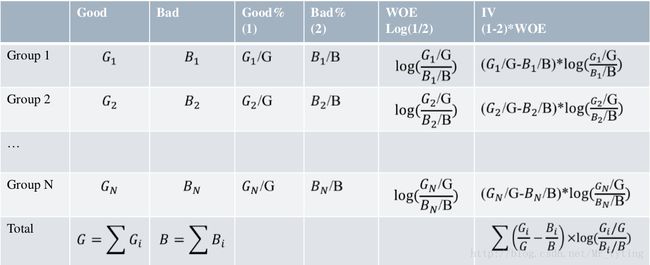
特征信息度解构:

其中Gi,Bi表示箱i中好坏样本占全体好坏样本的比例。
WOE表示两类样本分布的差异性。
(Gi-Bi):衡量差异的重要性。
特征信息度的作用
选择变量:
- 非负指标
- 高IV表示该特征和目标变量的关联度高
- 目标变量只能是二分类
- 过高的IV,可能有潜在的风险
- 特征分箱越细,IV越高
- 常用的阈值有:
<=0.02: 没有预测性,不可用
0.02 to 0.1: 弱预测性
0.1 to 0.2: 有一定的预测性
0.2 +: 高预测性
注意上面说的IV是指一个变量里面所有箱的IV之和。
计算WOE和IV代码:
def CalcWOE(df, col, target):
'''
:param df: dataframe containing feature and target
:param col: 注意col这列已经经过分箱了,现在计算每箱的WOE和总的IV。
:param target: good/bad indicator
:return: 返回每箱的WOE(字典类型)和总的IV之和。
'''
total = df.groupby([col])[target].count()
total = pd.DataFrame({'total': total})
bad = df.groupby([col])[target].sum()
bad = pd.DataFrame({'bad': bad})
regroup = total.merge(bad, left_index=True, right_index=True, how='left')
regroup.reset_index(level=0, inplace=True)
N = sum(regroup['total'])
B = sum(regroup['bad'])
regroup['good'] = regroup['total'] - regroup['bad']
G = N - B
regroup['bad_pcnt'] = regroup['bad'].map(lambda x: x*1.0/B)
regroup['good_pcnt'] = regroup['good'].map(lambda x: x * 1.0 / G)
regroup['WOE'] = regroup.apply(lambda x: np.log(x.good_pcnt*1.0/x.bad_pcnt),axis = 1)
WOE_dict = regroup[[col,'WOE']].set_index(col).to_dict(orient='index')
IV = regroup.apply(lambda x: (x.good_pcnt-x.bad_pcnt)*np.log(x.good_pcnt*1.0/x.bad_pcnt),axis = 1)
IV = sum(IV)
return {"WOE": WOE_dict, 'IV':IV}
那么可能有人会问,以上都是有监督的分箱,有监督的WOE编码,如何能将这些有监督的方法应用到预测集上呢?
我们观察下有监督的卡方分箱法和有监督的woe编码的计算公式不难发现,其计算结果都是以一个比值结果呈现(卡方分箱法:(坏样本数量-期望坏样本数量)/期望坏样本数量的比值形式;有监督的woe类似),比如我们发现预测集里面好坏样本不平衡,需要对坏样本进行一个欠采样或者是好样本进行过采样,只要是一个均匀采样,理论上这个有监督的卡方分箱的比值结果是不变的,其woe的比值结果也是不变的。即预测集上的卡方分组和woe编码和训练集上一样。
那么,在训练集中我们对一个连续型变量进行分箱以后,对照这这个连续型变量每个值,如果这个值在某个箱中,那么就用这个箱子的woe编码代替他放进模型进行训练。
在预测集中类似,但是预测集中的这个连续型变量的某个值可能不在任一个箱中,比如在训练集中我对[x1,x2]分为一箱,[x3,x4]分为一箱,预测集中这个连续变量某个值可能为(x2+x3)/2即不在任意一箱中,如果把[x1,x2]分为一箱,那么这一箱的变量应该是x1<=x< x2;第二箱应该是x2<=x< x4等等。***即预测集中连续变量某一个值大于等于第i-1个箱的最大值,小于第i个箱子的最大值,那么这个变量就应该对应第i个箱子。***这样分箱就覆盖所有训练样本外可能存在的值。预测集中任意的一个值都可以找到对应的箱,和对应的woe编码。
def AssignBin(x, cutOffPoints):
'''
:param x: the value of variable
:param cutOffPoints: 每组的最大值,也就是分割点
:return: bin number, indexing from 0
for example, if cutOffPoints = [10,20,30], if x = 7, return Bin 0. If x = 35, return Bin 3
'''
numBin = len(cutOffPoints) + 1
if x<=cutOffPoints[0]:
return 'Bin 0'
elif x > cutOffPoints[-1]:
return 'Bin {}'.format(numBin-1)
else:
for i in range(0,numBin-1):
if cutOffPoints[i] < x <= cutOffPoints[i+1]:
return 'Bin {}'.format(i+1)
如果我们发现分箱以后能完全能区分出好坏样本,那么得注意了这个连续变量会不会是个事后变量。
分箱的注意点
对于连续型变量做法:
- 使用ChiMerge进行分箱
- 如果有特殊值,把特殊值单独分为一组,例如把-1单独分为一箱。
- 计算这个连续型变量的每个值属于那个箱子,得出箱子编号。以所属箱子编号代替原始值。
def AssignBin(x, cutOffPoints):
'''
:param x: the value of variable
:param cutOffPoints: the ChiMerge result for continous variable
:return: bin number, indexing from 0
for example, if cutOffPoints = [10,20,30], if x = 7, return Bin 0. If x = 35, return Bin 3
'''
numBin = len(cutOffPoints) + 1
if x<=cutOffPoints[0]:
return 'Bin 0'
elif x > cutOffPoints[-1]:
return 'Bin {}'.format(numBin-1)
else:
for i in range(0,numBin-1):
if cutOffPoints[i] < x <= cutOffPoints[i+1]:
return 'Bin {}'.format(i+1)
- 检查分箱以后每箱的bad_rate的单调性,如果不满足,那么继续进行相邻的两箱合并,知道bad_rate单调为止。(可以放宽到U型)
## determine whether the bad rate is monotone along the sortByVar
def BadRateMonotone(df, sortByVar, target):
# df[sortByVar]这列数据已经经过分箱
df2 = df.sort([sortByVar])
total = df2.groupby([sortByVar])[target].count()
total = pd.DataFrame({'total': total})
bad = df2.groupby([sortByVar])[target].sum()
bad = pd.DataFrame({'bad': bad})
regroup = total.merge(bad, left_index=True, right_index=True, how='left')
regroup.reset_index(level=0, inplace=True)
combined = zip(regroup['total'],regroup['bad'])
badRate = [x[1]*1.0/x[0] for x in combined]
badRateMonotone = [badRate[i]上述过程是收敛的,因为当箱数为2时,bad rate自然单调
- 检查最大箱,如果最大箱里面数据数量占总数据的90%以上,那么弃用这个变量
def MaximumBinPcnt(df,col):
N = df.shape[0]
total = df.groupby([col])[col].count()
pcnt = total*1.0/N
return max(pcnt)
对于类别型变量:
- 当类别数较少时,原则上不需要分箱
- 否则,当类别较多时,以bad rate代替原有值,转成连续型变量再进行分箱计算。
def BadRateEncoding(df, col, target):
'''
:param df: dataframe containing feature and target
:param col: the feature that needs to be encoded with bad rate, usually categorical type
:param target: good/bad indicator
:return: the assigned bad rate to encode the categorical fature
'''
total = df.groupby([col])[target].count()
total = pd.DataFrame({'total': total})
bad = df.groupby([col])[target].sum()
bad = pd.DataFrame({'bad': bad})
regroup = total.merge(bad, left_index=True, right_index=True, how='left')
regroup.reset_index(level=0, inplace=True)
regroup['bad_rate'] = regroup.apply(lambda x: x.bad*1.0/x.total,axis = 1)
br_dict = regroup[[col,'bad_rate']].set_index([col]).to_dict(orient='index')
badRateEnconding = df[col].map(lambda x: br_dict[x]['bad_rate'])
return {'encoding':badRateEnconding, 'br_rate':br_dict}
-
否则, 检查最大箱,如果最大箱里面数据数量占总数据的90%以上,那么弃用这个变量
-
当某个或者几个类别的bad rate为0时,需要和最小的非0bad rate的箱进行合并。
### If we find any categories with 0 bad, then we combine these categories with that having smallest non-zero bad rate
def MergeBad0(df,col,target):
'''
:param df: dataframe containing feature and target
:param col: the feature that needs to be calculated the WOE and iv, usually categorical type
:param target: good/bad indicator
:return: WOE and IV in a dictionary
'''
total = df.groupby([col])[target].count()
total = pd.DataFrame({'total': total})
bad = df.groupby([col])[target].sum()
bad = pd.DataFrame({'bad': bad})
regroup = total.merge(bad, left_index=True, right_index=True, how='left')
regroup.reset_index(level=0, inplace=True)
regroup['bad_rate'] = regroup.apply(lambda x: x.bad*1.0/x.total,axis = 1)
regroup = regroup.sort_values(by = 'bad_rate')
col_regroup = [[i] for i in regroup[col]]
for i in range(regroup.shape[0]):
col_regroup[1] = col_regroup[0] + col_regroup[1]
col_regroup.pop(0)
if regroup['bad_rate'][i+1] > 0:
break
newGroup = {}
for i in range(len(col_regroup)):
for g2 in col_regroup[i]:
newGroup[g2] = 'Bin '+str(i)
return newGroup
- 当该变量可以完全区分目标变量时,需要认真检查该变量的合理性。(可能是事后变量)
单变量分析
- 用IV检验该变量有效性(一般阈值区间在(0.0.2,0.8))
iv_threshould = 0.02
## k,v分别表示col,col对应的这列的IV值。
varByIV = [k for k, v in var_IV.items() if v > iv_threshould]
## WOE_dict字典中包含字典。
WOE_encoding = []
for k in varByIV:
if k in trainData.columns:
trainData[str(k)+'_WOE'] = trainData[k].map(lambda x: WOE_dict[k][x]['WOE'])
WOE_encoding.append(str(k)+'_WOE')
elif k+str('_Bin') in trainData.columns:
k2 = k+str('_Bin')
trainData[str(k) + '_WOE'] = trainData[k2].map(lambda x: WOE_dict[k][x]['WOE'])
WOE_encoding.append(str(k) + '_WOE')
else:
print "{} cannot be found in trainData"
- 连续变量bad rate的单调性(可以放宽到U型)
- 单一区间的占比不宜过高(一般不能超过90%,如果超过则弃用这个变量)
多变量分析
变量的两两相关性,当相关性高时,只能保留一个:
- 可以选择IV高的留下
- 或者选择分箱均衡的留下(后期评分得分会均匀)
#### we can check the correlation matrix plot
col_to_index = {WOE_encoding[i]:'var'+str(i) for i in range(len(WOE_encoding))}
#sample from the list of columns, since too many columns cannot be displayed in the single plot
corrCols = random.sample(WOE_encoding,15)
sampleDf = trainData[corrCols]
for col in corrCols:
sampleDf.rename(columns = {col:col_to_index[col]}, inplace = True)
scatter_matrix(sampleDf, alpha=0.2, figsize=(6, 6), diagonal='kde')
#alternatively, we check each pair of independent variables, and selected the variabale with higher IV if they are highly correlated
compare = list(combinations(varByIV, 2))## 从varByIV随机的进行两两组合
removed_var = []
roh_thresould = 0.8
for pair in compare:
(x1, x2) = pair
roh = np.corrcoef([trainData[str(x1)+"_WOE"],trainData[str(x2)+"_WOE"]])[0,1]
if abs(roh) >= roh_thresould:
if var_IV[x1]>var_IV[x2]:## 选IV大的留下
removed_var.append(x2)
else:
removed_var.append(x1)
多变量分析:变量的多重共线性
通常用VIF来衡量,要求VIF<10:

import numpy as np
from sklearn.linear_model import LinearRegression
selected_by_corr=[i for i in varByIv if i not in removed_var]
for i in range(len(selected_by_corr)):
x0=trainData[selected_by_corr[i]+'_WOE']
x0=np.array(x0)
X_Col=[k+'_WOE' for k in selected_by_corr if k!=selected_by_corr[i]]
X=trainData[X_Col]
X=np.array(X)
regr=LinearRegression()
clr=regr.fit(X,x0)
x_pred=clr.predit(X)
R2=1-((x_pred-x0)**2).sum()/((x0-x0.mean())**2).sum()
vif=1/(1-R2)
print "The vif for {0} is {1}".format(selected_by_corr[i],vif)
当发现vif>10时,需要逐一剔除变量,当剔除变量Xk时,发现vif<10时,此时剔除{Xi,Xk}中IV小的那个变量。
通常情况下,计算vif这一步不是必须的,在进行单变量处理以后,放进逻辑回归模型进行训练预测,如果效果非常不好时,才需要做多变量分析,消除多重共线性。
本篇博文总结:

